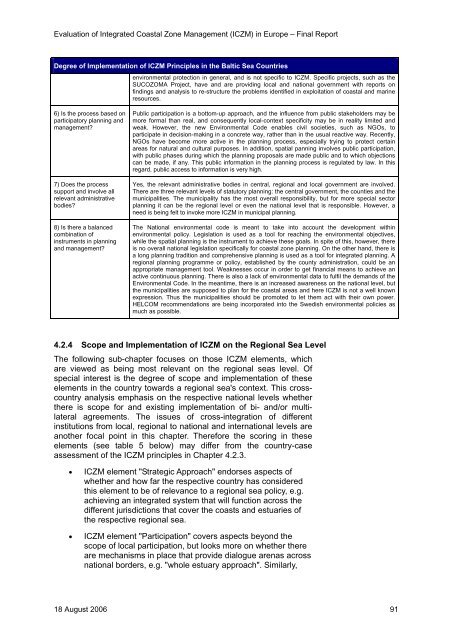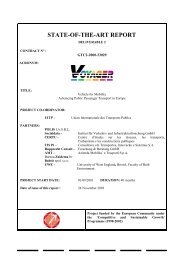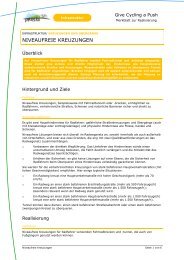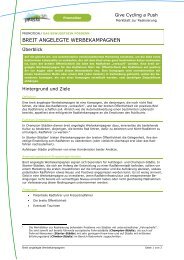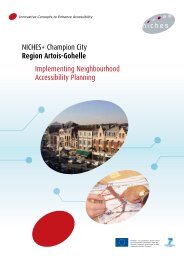Evaluation of Integrated Coastal Zone Management (ICZM) in ...
Evaluation of Integrated Coastal Zone Management (ICZM) in ...
Evaluation of Integrated Coastal Zone Management (ICZM) in ...
You also want an ePaper? Increase the reach of your titles
YUMPU automatically turns print PDFs into web optimized ePapers that Google loves.
<strong>Evaluation</strong> <strong>of</strong> <strong>Integrated</strong> <strong>Coastal</strong> <strong>Zone</strong> <strong>Management</strong> (<strong>ICZM</strong>) <strong>in</strong> Europe – F<strong>in</strong>al Report<br />
Degree <strong>of</strong> Implementation <strong>of</strong> <strong>ICZM</strong> Pr<strong>in</strong>ciples <strong>in</strong> the Baltic Sea Countries<br />
environmental protection <strong>in</strong> general, and is not specific to <strong>ICZM</strong>. Specific projects, such as the<br />
SUCOZOMA Project, have and are provid<strong>in</strong>g local and national government with reports on<br />
f<strong>in</strong>d<strong>in</strong>gs and analysis to re-structure the problems identified <strong>in</strong> exploitation <strong>of</strong> coastal and mar<strong>in</strong>e<br />
resources.<br />
6) Is the process based on<br />
participatory plann<strong>in</strong>g and<br />
management?<br />
7) Does the process<br />
support and <strong>in</strong>volve all<br />
relevant adm<strong>in</strong>istrative<br />
bodies?<br />
8) Is there a balanced<br />
comb<strong>in</strong>ation <strong>of</strong><br />
<strong>in</strong>struments <strong>in</strong> plann<strong>in</strong>g<br />
and management?<br />
Public participation is a bottom-up approach, and the <strong>in</strong>fluence from public stakeholders may be<br />
more formal than real, and consequently local-context specificity may be <strong>in</strong> reality limited and<br />
weak. However, the new Environmental Code enables civil societies, such as NGOs, to<br />
participate <strong>in</strong> decision-mak<strong>in</strong>g <strong>in</strong> a concrete way, rather than <strong>in</strong> the usual reactive way. Recently,<br />
NGOs have become more active <strong>in</strong> the plann<strong>in</strong>g process, especially try<strong>in</strong>g to protect certa<strong>in</strong><br />
areas for natural and cultural purposes. In addition, spatial pann<strong>in</strong>g <strong>in</strong>volves public participation,<br />
with public phases dur<strong>in</strong>g which the plann<strong>in</strong>g proposals are made public and to which objections<br />
can be made, if any. This public <strong>in</strong>formation <strong>in</strong> the plann<strong>in</strong>g process is regulated by law. In this<br />
regard, public access to <strong>in</strong>formation is very high.<br />
Yes, the relevant adm<strong>in</strong>istrative bodies <strong>in</strong> central, regional and local government are <strong>in</strong>volved.<br />
There are three relevant levels <strong>of</strong> statutory plann<strong>in</strong>g: the central government, the counties and the<br />
municipalities. The municipality has the most overall responsibility, but for more special sector<br />
plann<strong>in</strong>g it can be the regional level or even the national level that is responsible. However, a<br />
need is be<strong>in</strong>g felt to <strong>in</strong>voke more <strong>ICZM</strong> <strong>in</strong> municipal plann<strong>in</strong>g.<br />
The National environmental code is meant to take <strong>in</strong>to account the development with<strong>in</strong><br />
environmental policy. Legislation is used as a tool for reach<strong>in</strong>g the environmental objectives,<br />
while the spatial plann<strong>in</strong>g is the <strong>in</strong>strument to achieve these goals. In spite <strong>of</strong> this, however, there<br />
is no overall national legislation specifically for coastal zone plann<strong>in</strong>g. On the other hand, there is<br />
a long plann<strong>in</strong>g tradition and comprehensive plann<strong>in</strong>g is used as a tool for <strong>in</strong>tegrated plann<strong>in</strong>g. A<br />
regional plann<strong>in</strong>g programme or policy, established by the county adm<strong>in</strong>istration, could be an<br />
appropriate management tool. Weaknesses occur <strong>in</strong> order to get f<strong>in</strong>ancial means to achieve an<br />
active cont<strong>in</strong>uous plann<strong>in</strong>g. There is also a lack <strong>of</strong> environmental data to fulfil the demands <strong>of</strong> the<br />
Environmental Code. In the meantime, there is an <strong>in</strong>creased awareness on the national level, but<br />
the municipalities are supposed to plan for the coastal areas and here <strong>ICZM</strong> is not a well known<br />
expression. Thus the municipalities should be promoted to let them act with their own power.<br />
HELCOM recommendations are be<strong>in</strong>g <strong>in</strong>corporated <strong>in</strong>to the Swedish environmental policies as<br />
much as possible.<br />
4.2.4 Scope and Implementation <strong>of</strong> <strong>ICZM</strong> on the Regional Sea Level<br />
The follow<strong>in</strong>g sub-chapter focuses on those <strong>ICZM</strong> elements, which<br />
are viewed as be<strong>in</strong>g most relevant on the regional seas level. Of<br />
special <strong>in</strong>terest is the degree <strong>of</strong> scope and implementation <strong>of</strong> these<br />
elements <strong>in</strong> the country towards a regional sea's context. This crosscountry<br />
analysis emphasis on the respective national levels whether<br />
there is scope for and exist<strong>in</strong>g implementation <strong>of</strong> bi- and/or multilateral<br />
agreements. The issues <strong>of</strong> cross-<strong>in</strong>tegration <strong>of</strong> different<br />
<strong>in</strong>stitutions from local, regional to national and <strong>in</strong>ternational levels are<br />
another focal po<strong>in</strong>t <strong>in</strong> this chapter. Therefore the scor<strong>in</strong>g <strong>in</strong> these<br />
elements (see table 5 below) may differ from the country-case<br />
assessment <strong>of</strong> the <strong>ICZM</strong> pr<strong>in</strong>ciples <strong>in</strong> Chapter 4.2.3.<br />
• <strong>ICZM</strong> element "Strategic Approach" endorses aspects <strong>of</strong><br />
whether and how far the respective country has considered<br />
this element to be <strong>of</strong> relevance to a regional sea policy, e.g.<br />
achiev<strong>in</strong>g an <strong>in</strong>tegrated system that will function across the<br />
different jurisdictions that cover the coasts and estuaries <strong>of</strong><br />
the respective regional sea.<br />
• <strong>ICZM</strong> element "Participation" covers aspects beyond the<br />
scope <strong>of</strong> local participation, but looks more on whether there<br />
are mechanisms <strong>in</strong> place that provide dialogue arenas across<br />
national borders, e.g. "whole estuary approach". Similarly,<br />
18 August 2006 91


